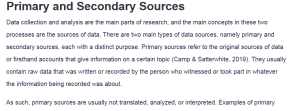Primary and Secondary Sources
Data collection and analysis are the main parts of research, and the main concepts in these two processes are the sources of data. There are two main types of data sources, namely primary and secondary sources, each with a distinct purpose. Primary sources refer to the original sources of data or firsthand accounts that give information on a certain topic (Camp & Satterwhite, 2019). They usually contain raw data that was written or recorded by the person who witnessed or took part in whatever the information being recorded was about.
As such, primary sources are usually not translated, analyzed, or interpreted. Examples of primary sources are the manuscripts of the New Testament that date back to the 2nd century, from which the modern-day Bible was translated. Primary sources are usually found in the form of archeological artifacts like drawings in caves, original manuscripts, diaries, memoirs, letters, autobiographies, scientific data and reports, minutes of meetings, statistical and survey data, personal narratives, oral histories, speeches, interviews, photographs, works of art, and case hearings, among others.
On the other hand, a secondary source refers to a source that is an interpretation, a summarization, discussion, or analysis of a primary source or another secondary source. The purpose of a secondary source is to present another layer of understanding and give more context to the original source or create an argument and give a conclusion (Camp & Satterwhite, 2019). Examples of such sources include magazine articles, reviews, scholarly journal articles, books, encyclopedia entries, biographies, and critiques of original works. An example of a secondary source is a history book that discusses historical events that took place in the last few centuries.
Primary source data can be obtained from several places, including museums and cultural institutions, where artifacts, such as excavated archeological material, can be preserved. Manuscripts of the Bible can also be found in these places. Primary sources can also be found in archives and libraries, whereby sources for history, arts, humanities, and original documents are kept. In addition, some archives and libraries have also digitized some primary sources by creating digital repositories where these sources can be easily accessed.
Examples include the Library of Congress Collections and Chronicling America: Historic American Newspapers. In addition, primary sources can be obtained from personal collections, which can be personal belongings that families keep of their ancestors, including their diaries and personal letters. Government records and other institutional records kept in various government facilities, such as evidence storage places, are also sources of obtaining primary sources.
Secondary hands can be obtained from several places, including academic journals, whereby scholars study original sources and then integrate their own research to disapprove, support, or add to the original sources. Another place where secondary sources like textbooks can be obtained is libraries, where other secondary sources like magazines, newspaper articles, and journals, among others, can also be found. In a world that is shifting away from written media to digitized media, most secondary sources can be found online, such as on websites and digital databases like Google Scholar and JSTOR.
In conclusion, primary sources are the original sources that contain raw data, while secondary sources are based on these primary sources. Both sources are important to research, with the former being the basis of inquiry while the latter explores the former to give a better understanding or contextualization.
References
Camp, S. C., Satterwhite, M. L. (2019). College English and business communication (11th ed.). McGraw-Hill Education.
ORDER A PLAGIARISM-FREE PAPER HERE
We’ll write everything from scratch
Question 
- Define primary sources and secondary sources. Where do you obtain primary source data?Where Are secondary sources found?

Primary and Secondary Sources